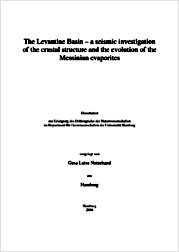The Levantine Basin
a seismic investigation of the crustal structure and the evolution of the Messinian evaporites
Netzeband, Gesa Luise
Univ. Hamburg
Monography
Verlagsversion
Englisch
Netzeband, Gesa Luise, 2006: The Levantine Basin - a seismic investigation of the crustal structure and the evolution of the Messinian evaporites. Univ. Hamburg, DOI: 10.23689/fidgeo-348.
 |
View/
|
The Levantine Basin - a seismic investigation of the crustal structure and the evolution of the Messinian evaporites ABSTRACT This work presents an analysis of the crustal structure of the Levantine Basin, based on refraction seismic and gravity data, and an analysis of the evolution of the Messinian evaporites, based on reflection seismic data. Forward and inverse modelling of refraction seismic traveltimes along two profiles yielded 2-D velocity-depth-profiles. Gravity modelling along these profiles provided further information on the crustal structure. A great number of reflection seismic profiles was used for the analysis of the Messinian evaporites, which allowed an exhaustive investigation of the geometry of the evaporite layers, depositional phases of the evaporites and of their structural evolution. The Levantine Basin is located in the Southeastern Mediterranean Sea. The basin and its margin are key areas for the understanding of the geodynamic evolution of the Eastern Mediterranean. The opening of the Levantine Basin is closely related to the opening of the Neo-Tethys. Many geodynamic reconstructions of this area have been developed, but the key question, the origin of the crust, remained open. The Levantine Basin is also a world class site for studying the initial stages of salt tectonics driven by differential sediment load. The Messinian evaporites are comparatively young (deposited during the Messinian Salinity Crisis 5.9 - 5.3 Ma ago), the sediment load varies along the basin margin, they are hardly tectonically overprinted, and the geometry of the basin and the overburden is well-defined...

